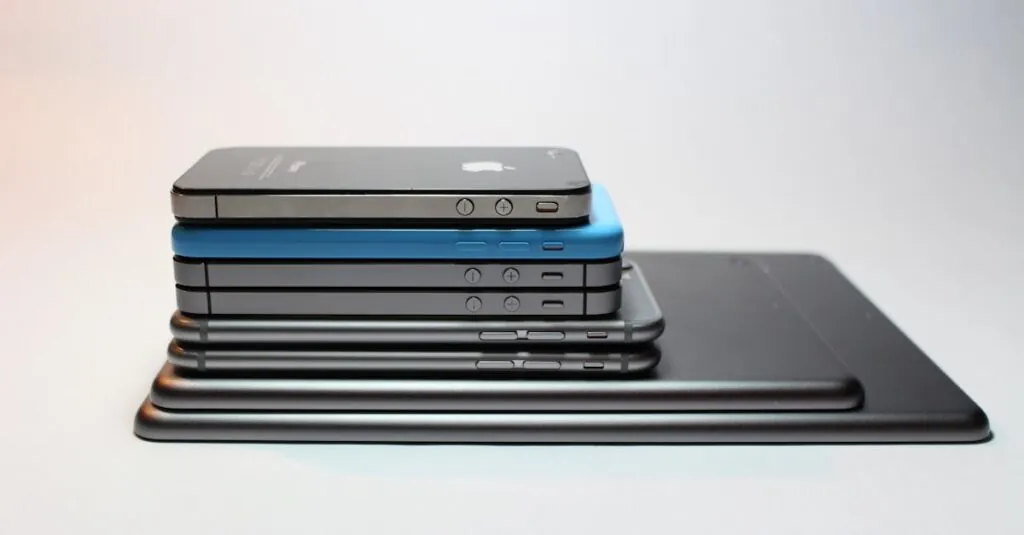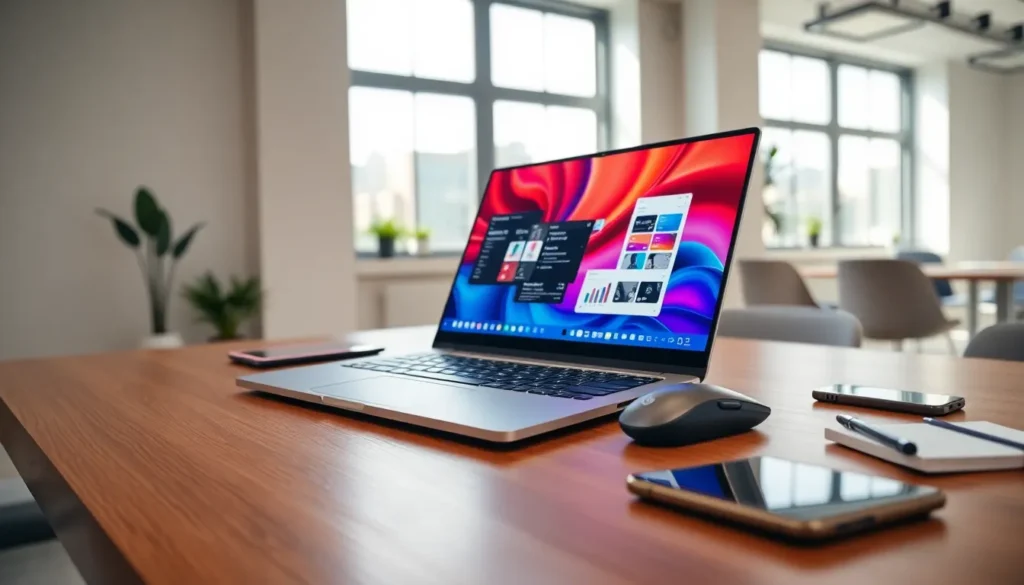Table of Contents
ToggleIn a world where mobile phones are practically an extension of ourselves, it’s hard to imagine life without them. From the moment the alarm goes off to the late-night scroll through social media, these little gadgets have woven themselves into the fabric of daily life. They’re not just for calls anymore; they’re our cameras, our calendars, and even our personal trainers.
Overview of Mobile Phones
Mobile phones serve as vital tools in daily life, offering functionalities that extend far beyond voice calls. They encompass various features, including high-resolution cameras, navigation systems, and application platforms. Individuals often rely on these devices for instant communication, access to information, and entertainment.
Smartphones dominate the mobile phone market, with over 80% of users opting for these multifunctional devices. They integrate technology that allows for seamless social media interaction, online shopping, or video streaming. In applications such as fitness tracking, smartphones transform personal health management, as they help track steps, monitor heart rates, and provide workout schedules.
Battery life remains a pivotal consideration for users, with many requiring devices that last all day. Manufacturers are aware of this demand; thus, they continuously innovate with fast-charging and energy-efficient batteries. Screen size and resolution also influence consumer choices, as preferences vary from compact devices to larger screens for immersive media experiences.
Security features, such as biometric authentication and encryption, play a significant role in consumer satisfaction. Users prioritize protection against unauthorized access to sensitive data. Manufacturers implement advanced technologies to enhance security measures, ensuring peace of mind for mobile phone users.
Mobile phones also facilitate business operations. Professionals often depend on their devices for email communication, video conferencing, and access to productivity applications. This crucial role further emphasizes how mobile phones have reshaped personal and professional interactions in today’s fast-paced world.
Key Features of Mobile Phones
Mobile phones provide an array of features that enhance user experience and functionality. These capabilities cater to various needs ranging from entertainment to business.
Display Technology
Display technology significantly impacts user engagement. AMOLED and LCD screens dominate the market, providing vivid color and sharp images. High refresh rates, often reaching 120 Hz, enable smoother scrolling and improved gaming experiences. Additionally, resolutions such as Full HD or 4K enhance visual clarity, making streaming videos enjoyable. Users often prioritize larger displays for multitasking, allowing for efficient app usage side by side.
Battery Life
Battery life remains a crucial factor for mobile phone users. Devices typically feature batteries ranging from 3,000 mAh to over 5,000 mAh, catering to different usage levels. Fast charging capabilities, available in many models, allow for quick power-ups during busy schedules. Users benefit from features like power-saving modes, prolonging battery life during intensive tasks. As lifestyle demands increase, manufacturers continue to innovate in battery efficiency and longevity.
Camera Quality
Camera quality significantly influences purchasing decisions. Many smartphones boast multiple lenses, enhancing versatility for photography. Common features include wide-angle, telephoto, and macro lenses, allowing users to capture a range of scenes. The introduction of night mode improves low-light performance, appealing to avid photographers. Additionally, image processing techniques, such as AI enhancement, create stunning photos with minimal effort. Regular updates and software improvements maintain the camera’s quality, ensuring users enjoy cutting-edge technology in photography.
Popular Mobile Phone Brands
Several brands dominate the mobile phone market, each offering unique features and innovations that cater to diverse consumer needs.
Apple
Apple consistently sets trends with its iPhone lineup. Known for premium design, iPhones integrate iOS for a seamless user experience. High-quality cameras and robust security features appeal to tech-savvy consumers. Additionally, Apple’s ecosystem allows easy connectivity with other devices, such as Macs and iPads. The latest models, like the iPhone 14 series, showcase advancements in camera technology and battery efficiency, solidifying Apple’s position in the premium segment.
Samsung
Samsung remains a top competitor in the smartphone arena. Their Galaxy series offers a variety of devices, catering to different budgets. Notable for AMOLED displays, Samsung phones provide vibrant colors and excellent viewing angles. Furthermore, innovative features like S Pen functionality in Galaxy Notes enhance productivity. The Galaxy S23 series illustrates Samsung’s commitment to camera quality and battery life, making it a preferred choice for many consumers.
Google emphasizes software optimization with its Pixel series of smartphones. A standout feature includes stock Android, allowing users to receive timely updates and a clean interface. Excellent camera capabilities, powered by computational photography, set Pixel devices apart from competitors. Models like the Pixel 7 enhance the user experience with features such as Night Sight and Magic Eraser. Additionally, seamless integration with Google services provides a streamlined approach to everyday tasks.
Trends in Mobile Phone Technology
Mobile phone technology continues to evolve rapidly, introducing innovative features that reshape user experiences.
Foldable Phones
Foldable phones represent a major advancement in mobile technology, allowing users to enjoy larger screens in a compact design. These devices use flexible displays, enabling seamless transitions between phone and tablet modes. Popular models, such as Samsung Galaxy Z Fold and Huawei Mate X, exemplify this trend. Foldable phones cater to creative and productivity-focused users, enhancing the multitasking capabilities of mobile devices. The folding mechanism has improved significantly, ensuring durability and reliability. As more manufacturers enter the foldable market, versatility and design options expand for consumers.
5G Connectivity
5G connectivity transforms mobile usage by providing faster data speeds and lower latency. It enhances streaming, gaming, and video conferencing experiences. Users can download large files in seconds, revolutionizing mobile internet access. The rollout of 5G networks accelerates, with numerous cities already equipped with this technology. Devices supporting 5G are increasingly popular, as they offer greater performance compared to their 4G counterparts. Enhanced connectivity opens the door for innovations, such as augmented reality apps and IoT integration. Consumers can expect a more seamless mobile experience with expanding 5G capabilities.
Mobile phones have undeniably reshaped the way individuals interact with the world around them. Their evolution from simple communication devices to multifunctional tools has made them indispensable in everyday life. As technology continues to advance, the features and capabilities of these devices will only improve, enhancing user experiences further.
With the rise of 5G and innovative designs like foldable phones, the future of mobile technology looks promising. Consumers can expect even more seamless integration of their personal and professional lives through these advancements. Ultimately, mobile phones will continue to be at the forefront of communication and connectivity, adapting to meet the ever-changing needs of users.




